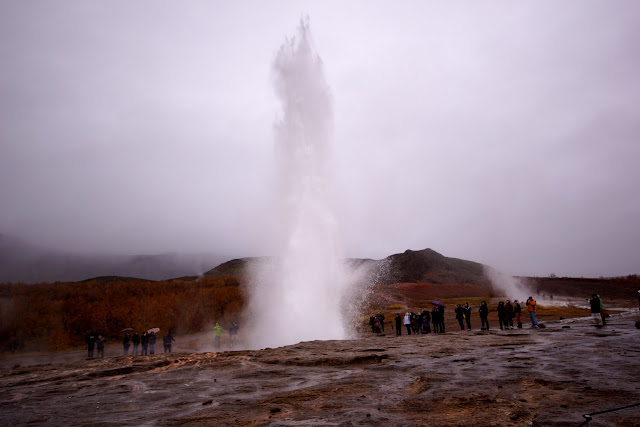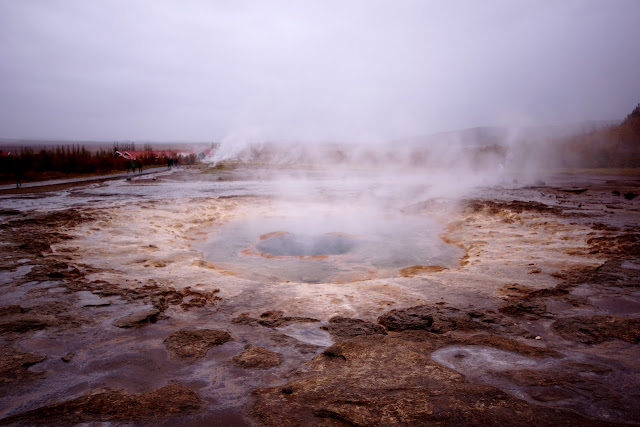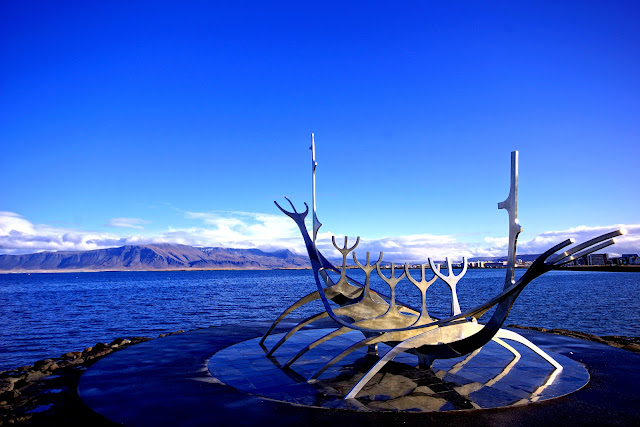The Land of Ice and Fire is how Iceland likes to brand itself, not entirely unreasonably either. It's home to many glaciers, including Europe's largest, and is the second most volcanic country in the world after Hawaii. But I would recommend, just for accuracy's sake you understand, the slight addendum of 'and rain'. In the days we were there it only stopped raining for 100 minutes; admittedly they were an amazing 100 minutes with some of the most crystal clear light and beautiful countryside I've ever seen but still. Now I know what you're thinking: the Welsh tourist board has already cornered that market, but I don't see why they couldn't come to some sort of mutual agreement.
When you live in a place where you're likely to spend a large portion of the year battling the elements it's always nice to know that at the end of the day you can have a nice hot bath and, thanks to another aspect of Iceland's extreme nature, Icelanders have a better deal than most. 14% of the surface of Iceland is covered by lakes, there are many underground reservoirs too and where these are found near to one of the many vents to the Earth's core that the country straddles the result is a vast aquifer of ready made bath water. You see, the mains water that gets pumped into Reykjavik isn't cold like ours but piping hot and so whereas we have to wait for the water to get hot they often have to wait for the water to get cold.
The reason Iceland is so geologically active is that it sits astride the mid-Atlantic ridge, in fact, worse than that, the fault line actually splits in two right in the middle of the country. This has resulted in there being more than 30 active volcanic systems in the country and one third of the total magma that has erupted to the Earth's surface in the last 500 years has been on this one island. In 1783 the Laki volcano erupted, and it was a real monster. The guy that told me about it said for me to look up the history of my country, or any country in the northern hemisphere, for that year and it would be mentioned; and he was right. That summer was known as the Sand Summer in the UK because the sky was changed to a pallid yellow from all the sulphur that was belched into the atmosphere. Ten thousand Britons were killed by the fallout from the eruption. One third of the population of Iceland were killed. Chilling statistics like that is probably why locals were all a bit nonplussed when their last major eruption was under way resulting in flights throughout northern Europe being grounded due to worries about the ash cloud. Apparently they found it genuinely amusing that people would get so worked up by such a small eruption and annoyed that the world seemed incapable of pronouncing a simple word like Eyjafjallajökull.
All the poor weather we encountered meant that there was no chance of seeing the Northern Lights, which was a shame but not a surprise as I knew before we left that solar activity was low. Luckily, though, we did get to see the other main thing that I wanted to get out of the trip, whales. Minke whales, to be precise. These baleen whales are normally solitary but we managed to find two together that were presumably feeding on a ball of herring or some other such fishy goodness. The rolling of the waves and the lash of the wind and rain meant that the only vaguely in focus shot I managed to get was less than impressive but, for me, this particular encounter wasn't about photography, it was about seeing one of nature's wonders up close and personal. So although I didn't get a heap of shots of humpbacks breaching and fluking I was still more than pleased with my day.
When I'm away I now increasingly approach any new place with a view to how I'm going to represent it on this blog. What story am I going to tell? What are the key elements I need to photograph? What caption would fit here? And if I come up with a good turn of phrase I'll quickly note it down knowing that my awful memory will inevitably let it fall from it's grasp. But on this occasion I was content to just stand there trying to guess where they would surface next whilst simultaneously trying to dodge the increasing quantity of vomit puddles on deck and not fall into the briny deep. And there was a lot to dodge too, let me tell you; I hadn't seen that many people vomiting with wild abandon in one place since my last night out in Cardiff. Sue does not cope well on boats and, whilst she wasn't a contributor to the fish food being mopped overboard that day, she felt pretty rough the whole time we were out there but she manfully fought it all the way and coped extremely well. As we chugged back into the harbour she said that I have my 'roller coaster' face on. For those that haven't gone on a trip to Alton Towers with me this basically means I have a fixed grin on my face combined with a sort of wildness in the eyes that gives me an altogether unhinged appearance. This means I've had fun. The only slightly unsettling thing about the trip was that in the opposite berth to our whale spotting ship were two whale hunting ships; a stark reminder that these impressive creatures have no protection in Icelandic waters. The argument goes that they have been doing this for a thousand years, it's a part of their culture, why should they have to stop now?
More of a struggle was our next excursion where the plan was to spend the day going to Thingvellir, the seat of Iceland's ancient parliament the Althingi; a set of geysers, one of which is called geyser and is what every other geyser in the world is named after; and also the Gullfoss waterfall. The weather was absolutely appalling, incessantly, all day and it was particularly annoying for this last item on the agenda as it is one of the most impressive waterfalls I've ever had the good fortune to visit. I could have easily spent a whole day just photographing this one location but all that I could do was snatch a few hastily composed shots before my camera got saturated. The photo I've included here has rain drops on the lens and the sky looks miserable; it's a damned fine waterfall, though. I could probably say the same thing about the geyser; to really appreciate it you would need a nice blue sky to give some contrast to the vast, boiling jet of water that surges upwards every 4-8 minutes. As it was, in my photos, it just sort of blends into the background so that you can't really get a feel for the dynamism of the moment.
Before we set off on this trip there were several 'facts' about Iceland that I wanted to check out, like: Iceland has no trees; Iceland has no dogs; in any town there is only one shop where you can buy alcohol and it's run by the Government, and a few others. It turns out that only the last of these is true. Iceland does have trees but the rule of thumb is that if it is taller than a man then it is an imported species. The saying goes that if you ever get lost in an Icelandic forest then just stand up. And Iceland definitely has dogs, in fact it even has native dogs. When the first human settlers arrived the Arctic fox was the only mammal living on the island. That has now changed with the introduction of sheep, reindeer, rabbits and the inevitable rats and mice. A generation ago a farmer asked permission of the Government to import some mink so that he could farm them for their fur. The Government said no on the grounds that they might escape and overrun the country. The farmer continued to apply for years but the answer was always the same. Eventually the farmer died but then his son took up the cause and continued to apply. He commissioned specially built mink-proof cages from which there could be no escape and, eventually, the authorities relented and granted him a license. Within four days the mink had escaped and so they complete the list of mammals you can find in Iceland.
When I'm away I now increasingly approach any new place with a view to how I'm going to represent it on this blog. What story am I going to tell? What are the key elements I need to photograph? What caption would fit here? And if I come up with a good turn of phrase I'll quickly note it down knowing that my awful memory will inevitably let it fall from it's grasp. But on this occasion I was content to just stand there trying to guess where they would surface next whilst simultaneously trying to dodge the increasing quantity of vomit puddles on deck and not fall into the briny deep. And there was a lot to dodge too, let me tell you; I hadn't seen that many people vomiting with wild abandon in one place since my last night out in Cardiff. Sue does not cope well on boats and, whilst she wasn't a contributor to the fish food being mopped overboard that day, she felt pretty rough the whole time we were out there but she manfully fought it all the way and coped extremely well. As we chugged back into the harbour she said that I have my 'roller coaster' face on. For those that haven't gone on a trip to Alton Towers with me this basically means I have a fixed grin on my face combined with a sort of wildness in the eyes that gives me an altogether unhinged appearance. This means I've had fun. The only slightly unsettling thing about the trip was that in the opposite berth to our whale spotting ship were two whale hunting ships; a stark reminder that these impressive creatures have no protection in Icelandic waters. The argument goes that they have been doing this for a thousand years, it's a part of their culture, why should they have to stop now?
 |
| Minke whales are known for the small size of their dorsal fin compared to their body size |
More of a struggle was our next excursion where the plan was to spend the day going to Thingvellir, the seat of Iceland's ancient parliament the Althingi; a set of geysers, one of which is called geyser and is what every other geyser in the world is named after; and also the Gullfoss waterfall. The weather was absolutely appalling, incessantly, all day and it was particularly annoying for this last item on the agenda as it is one of the most impressive waterfalls I've ever had the good fortune to visit. I could have easily spent a whole day just photographing this one location but all that I could do was snatch a few hastily composed shots before my camera got saturated. The photo I've included here has rain drops on the lens and the sky looks miserable; it's a damned fine waterfall, though. I could probably say the same thing about the geyser; to really appreciate it you would need a nice blue sky to give some contrast to the vast, boiling jet of water that surges upwards every 4-8 minutes. As it was, in my photos, it just sort of blends into the background so that you can't really get a feel for the dynamism of the moment.
Before we set off on this trip there were several 'facts' about Iceland that I wanted to check out, like: Iceland has no trees; Iceland has no dogs; in any town there is only one shop where you can buy alcohol and it's run by the Government, and a few others. It turns out that only the last of these is true. Iceland does have trees but the rule of thumb is that if it is taller than a man then it is an imported species. The saying goes that if you ever get lost in an Icelandic forest then just stand up. And Iceland definitely has dogs, in fact it even has native dogs. When the first human settlers arrived the Arctic fox was the only mammal living on the island. That has now changed with the introduction of sheep, reindeer, rabbits and the inevitable rats and mice. A generation ago a farmer asked permission of the Government to import some mink so that he could farm them for their fur. The Government said no on the grounds that they might escape and overrun the country. The farmer continued to apply for years but the answer was always the same. Eventually the farmer died but then his son took up the cause and continued to apply. He commissioned specially built mink-proof cages from which there could be no escape and, eventually, the authorities relented and granted him a license. Within four days the mink had escaped and so they complete the list of mammals you can find in Iceland.
 |
| The lower section of the Gullfoss falls |
I really enjoyed our time in Iceland. At times the weather had completely kicked our arse but it was always beautiful and always compelling. If it wasn't so damned expensive it would definitely be a regular haunt as it only takes three hours to get to and has lots to offer anyone that likes wild landscapes and a strong Arctic wind. At some point we were looking through our guidebook and it mentioned that Reykjavik is the northern-most capital in the world; I love this sort of thing. I like having things that I can tick off of a list, especially things of a geographical nature such as this. It can go on the list right under the other places I've gone like southern-most town, northern-most town, highest altitude town. As we were discussing this, and as we rapidly approach our tenth anniversary of travelling the world together, we decided to tot up all the different countries we had visited as a pair, ignoring ones we had gone to the one without the other. We were somewhat startled to come to a total of 25 countries, an eighth of the world's total. That's good going; but then we realised that at that pace it'd take 80 years to get them all done - the Ultimate List. Must up the pace.






